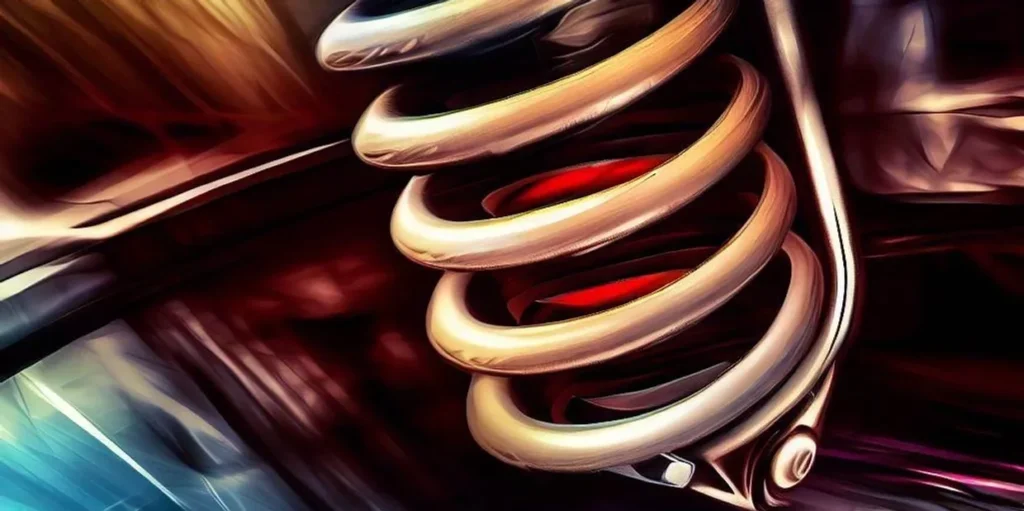
SPRING RATES
Spring Rate Tuning in Racing Cars
In this post, we are going to deep dive into suspension spring rates and how you can tune them in sim racing.
These ideas will be applicable to Assetto Corsa Competizione (ACC), Rfactor 2 (RF2), IRacing, Automobilista 2 (AMS2) and RaceRoom Racing Experience (R3E). Basically it will apply to any sim racing title.
Spring Rates and Car Setup: A Guide for Sim Racers
If you are a fan of sim racing games like Assetto Corsa Competizione, rFactor 2 and Automobilista 2, you might have wondered how to tweak your car setup to get the best performance and handling. One of the most important aspects of car setup is the spring rate, which is the stiffness of the suspension springs. In this blog post, we will explain what spring rate is, how it affects the car’s behavior, and how to adjust it for different scenarios.
What is Spring Rate?
Spring rate is the measure of how much force is required to compress or extend a spring by a certain distance. It is usually expressed in units of N/mm or lb/in. The higher the spring rate, the stiffer the spring and the more resistant it is to deformation. Spring rates are used in conjunction with anti roll bars in order to further fine tune the car when under lateral load. To further control the car’s balance, we can use dampers too.
Spring rate affects how the car reacts to bumps, corners, braking and acceleration. It also influences the mechanical grip, which is the amount of traction generated by the tires and suspension. Mechanical grip is essential for low-speed corners and wet conditions.
How Spring Rate Affects Car Behavior
The spring rate determines how much the car’s body (or chassis) moves relative to the wheels. This movement affects the weight distribution, tire contact patch, aerodynamics and suspension geometry of the car. Having a stable car is vital, especially for longer endurance races.
A stiffer spring rate reduces body movement and keeps the car more stable and responsive. However, it also reduces mechanical grip and makes the car more sensitive to bumps and road imperfections. A softer spring rate allows more body movement and increases mechanical grip and ride comfort. However, it also makes the car more prone to body roll, pitch and dive, which can affect the balance and stability of the car.
The optimal spring rate depends on various factors, such as the track layout, surface condition, driving style and personal preference. Generally speaking, a stiffer spring rate is better for smooth and fast tracks with high-speed corners, where aerodynamic grip and stability are more important. A softer spring rate is better for bumpy and slow tracks with low-speed corners, where mechanical grip and traction are more important. But, we also need to be aware of the role that dampers play in terms of controlling the speed of the suspension compression, therefore, pitch stability.
Tips and Tricks for Spring Rate Tuning
Start with a baseline setup that suits your car and track. You can use the default setups provided by the game or download setups from other players online.
- Test your setup in different conditions and scenarios, such as different weather, tire compounds (if applicable in your sim), fuel loads and driving times (as this can affect tyre tempratures).
- Use telemetry tools or apps to analyze your lap times, sector times, speed traps, tire temperatures, suspension travel and other data. Motec is great for this!
- Make small changes at a time and note down their effects on your performance and handling.
- Identify what the car is doing and what you want it to do
- Pay attention to where the car is obviously out of balance on entry, mid corner and exits
- Do not overdrive during the test sessions as you introduce an inaccurate variable. Remember, we are chasing the setup of the car, not the driver!
Soft Springs
– Pros of soft spring rates on a race car:
– Better grip on bumpy or uneven surfaces
– More comfortable ride for the driver
– Less stress on the suspension components
– Cons of soft spring rates on a race car:
– Reduced cornering speed and stability
– Increased body roll and weight transfer
– Higher risk of bottoming out or scraping the ground
Stiff Springs
– Pros of stiff suspension spring rates on a race car:
– Reduce body roll and improve cornering stability – (can be tweaked with Anti-Roll Bars)
– Increase grip and traction on smooth surfaces
– Allow for more precise steering and handling
– Better aero balance and pitch control.
– Cons of stiff spring rates on a race car:
– Tyres can “skip and slide” across the track surface (higher tyre temperatures and graining)
– Decrease grip and traction on bumpy or uneven surfaces
– Increase the likelihood of bad landings and instability on taking kerbs
– Higher likelihood of snap oversteer on exits, as the rear is not allowed to squat down






